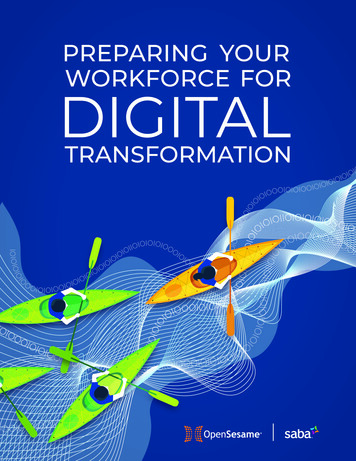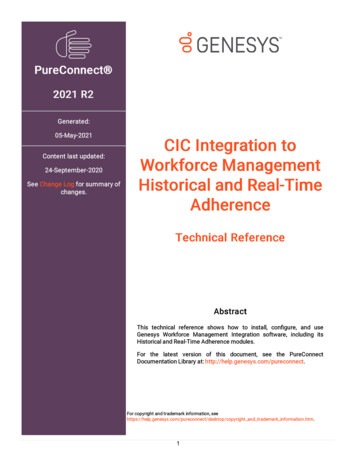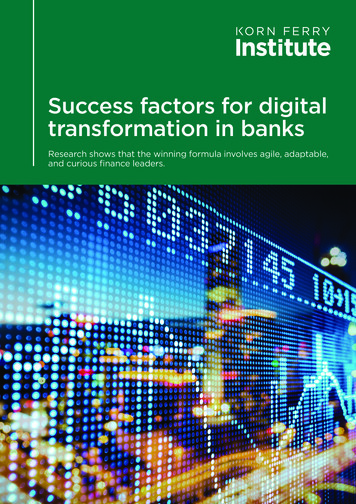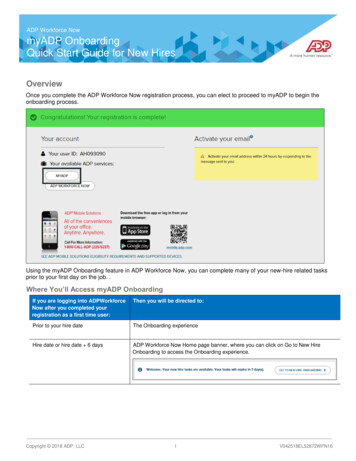
Transcription
PREPARING YOURWORKFORCE FORDIGITALTRANSFORMATION
Table of ContentsReady or Not. Digital Transformation is Here 3What is Digital Transformation? 4Is Your Organization Ready for Digital Transformation? 5How to Make Talent Development a Priority in theAge of Digital Transformation 65 Talent Development Strategies to Get Your People Ready for a New Digital Reality 7Coaching Strategies to Prepare Your Workforce for Digital Transformation 8Support ongoing skill development 9Coach for growth 11Push decision-making further down into the organization 13How a Learning-Focused Culture Can Help PeopleThrive in the Digital Age 15Digital-Focused Strategies to Build a Learning Culture 16Create a learning environment 17Embrace new talent technologies 19Support and Prepare Your Workforce – Now, and Into the Future 21How Saba and OpenSesame Can Help 22References 23
Ready or Not.Digital Transformation is HereThe ever-evolving nature of technology rapidly changes the way we dobusiness – it affects everything from who our customers are and what wesell, to our tools and processes, to our employees and work environments.How well organizations adapt to the newSo it’s no surprise that Gartner recentlyand exciting impacts of digital innovationsfound that by 2022, almost 80 percentand processes determines their long-termof organizational skills will have to besuccess. Digital transformation isn’t only“reprioritized or revisited” due to digitalexciting – it’s also a universal reality. Nobusiness transformation.2 It’s critical thatindustry is immune to digital disruption.businesses recruit, retain and develop1the right talent to stay competitive nowA 2014 study from Constellation Researchand into the future. Digital-focused talentconcluded that industry-leading companies’management and talent developmentability to adapt to digital disruption was a keystrategies remain integral to business successfactor in their long-term success. In analyzingover the long-term.the average tenure of companies on theFortune 500 list, researchers found that, sinceTo stay competitive in these emerging and2000, digital disruption caused 52 percentmaturing digital environments, companiesof these companies to declare bankruptcy,need to intentionally implement andgo through an acquisition or simply cease toexecute a digital transformation strategyexist. They didn’t adapt well enough or fastacross critical areas of the business – fromenough to their changing digital reality.organizational strategy and structure to52%Since 2000,of companieson the Fortune 500 declaredbankruptcy, went throughan acquisition or simplyceased to exist.culture and talent development.48% adapted to thechanging digital realityPreparing Your Workforce for Digital Transformation 3
What is Digital Transformation?To answer this question we need to first talk about digital disruption.Holger Mueller of the Constellation Group describes digital disruption as,“The creation, implementation and operation of new best practices andbusiness models, enabled by digital technologies.” Disruption comes inthe form of “macro trends, changes in the dynamic workforce, disruptivetechnology adoption, [or] the creation of new digital business models.”3In industries from banking to retail, media,operations, and how it fundamentally addslogistics, manufacturing, education,value to its customers now, and into theprofessional services and life sciences,future. Digital transformation requires aleaders are struggling to face up to new,radical rethinking of how an organizationdisruptive, technology-driven businessleverages technology and processes tomodels. Although the word “disruption” hasdramatically change business performance.negative connotations, in the context ofAnd it all starts with – you guessed it – yourdigital transformation, if addressed effectively,people.disruption can bring enormous benefits.Digital transformation is already here. And itDigital transformation is the profoundmeans that the ability to adapt and succeedchange an organization experiences becausein a rapidly changing market is critical.of digital disruption, including to its culture,In this eBook, we’ll share the talent development best practices you –and your people – need in order to futureproof your organization while puttingyour people in the driver’s seat of their own experience.4 Preparing Your Workforce for Digital Transformation
Is Your Organization Ready forDigital Transformation?Digital disruption is creating new challenges in how organizations viewand manage their talent. The Digital Age, aka The Information Age, beganin the 1970s and technological advances have been accelerating ever since.But talent management practices that drove company success in the pastmay not drive similar results into the future.To support their organizations throughmanagers and employees need to bedigital transformation, Human Resourcessuccessful in order to move the needle(HR) and Learning and Development (L&D)on business performance. That meansprofessionals need to take their place asestablishing a continuous, hyper-connecteda true business partner and mount theirdevelopment experience for people thatown talent management transformationaligns to the ever-shifting goals of theinitiatives. HR leaders need a frameworkbusiness. In practice, that means creating ato identify, support and develop the skillsdigitally centered, learning-focused, talentand relevant competencies that leaders,development environment.Preparing Your Workforce for Digital Transformation 5
How toMake TalentDevelopmenta Priority in theAge of DigitalTransformation
5 Talent Development Strategiesto Get Your People Ready for aNew Digital RealityThe rise of digital is transforming bothtalent management is an urgent issue. Whatbusiness needs and talent developmentthis requires is a [talent development] functionpractices. The World Economic Forum foundthat is rapidly becoming more strategic andthat, “[A]s the rate of skills change accelerateshas a seat at the table.”4 Simply put, preparingacross both old and new roles in all industries,your workforce for digital transformationproactive and innovative skill-building andrequires a talent development strategy.Here, we explore five talent development best practicesto get your people ready for a new digital reality.3Push decisionmaking furtherdown into theorganization1Support ongoingskill developmentCoachingStrategiesEmbracenew talenttechnologies52Coach for growthLearningCulture4Create a learningenvironmentPreparing Your Workforce for Digital Transformation 7
312Coaching Strategiesto Prepare YourWorkforce for DigitalTransformation8 Preparing Your Workforce for Digital Transformation
1Support ongoingskill developmentSupporting ongoing skill development has never been more criticalthan now – in a competitive market where there are more jobs availablethan talent to fill these roles. Once organizations attract their rock stars,they must invest in developing their people to sharpen skills, keep talentengaged, safeguard institutional knowledge, and drive business outcomes.In a recent Gartner leadership survey, CEOsThe clear solution? Support employees byidentified “access to the right talent andproviding them with the resources andskills” as the number one internal constraintguidance they need to develop new, usefulto business growth, which is a major hurdleskills and close performance gaps. The key?when digital-focused growth is an equallyFor high-performing organizations, learningcritical priority. So it’s no surprise that atisn’t the outcome – it’s the behavior thatleast one in four workers in OECD countriesdrives performance.5report a skills mismatch in regards to theproficiencies required in their current jobs.6Amongst high-performing organizations, Brandon Hall Group found:751%link L&D objectives todepartmental goals42%link L&D objectivesto individual performance reviewsPreparing Your Workforce for Digital Transformation 9
Why employee developmentpractices need to evolveTo work effectively in a digital environment:73%44%of employees report requiring askills update at least every six monthswhilesay they mustupskill “continuously.”8To keep pace, organizations must deliverenough. To remain competitive in an era ofpersonalized, continuous learning experiencesdigital transformation, managers need tothrough on-the-job AND formal trainingsupport their people as they work to developprograms to help employees develop digitalnew skills and achieve goals that contribute toliteracy among other critical skills. Butpositive business outcomes. In short, learningoffering these opportunities isn’t quitemust be personalized but also relevant.RESOURCES:eBook: The Learningand PerformanceLink: Making theConnection10 eBook: How toExcel at GoalManagementPreparing Your Workforce for Digital TransformationHow-to Article:Writing SMARTGoals
Coach for growth2Provide the ongoing coaching and feedback your people need to reachtheir goals, develop new skills and improve performance.Once employee goals are aligned toThe 1:1 meeting is a tool both managersstrategic business objectives, managers canand employees can take advantage of asfacilitate coaching and feedback duringorganizations make the shift from traditionalregular check-in meetings where theyperformance management (marked by thecan discuss performance, goal progress,dreaded, once-a-year appraisal) to forward-challenges and milestones, and careerthinking, ongoing talent development wheredevelopment opportunities.regular performance and developmentconversations are the norm.The advantages of 1:1 meetings:Drive accountabilitywith regulargoal updatesBuild a cultureof feedbackBoost employeeengagement,retention andproductivityRecord employeeprogress, roadblocksand key winsGet employeesthinking abouttheir next careerstepsStrengthen therelationship betweenthe manager andthe employeePreparing Your Workforce for Digital Transformation 11
In this era of digital transformation, employees are increasinglybecoming subject matter experts and can use 1:1 meetings as anopportunity to flag concerns, share new ideas, and give upwardfeedback about their organization’s priorities, systems and processes.But establishing an open, two-way dialogueThe good news is that 1:1 meetings are strongonly works when an organization hascoaching tools that can be implementedcreated a culture of feedback, which is whyat all levels of the organization. And whenemployees aren’t the only ones who needmanagers know what their employees’coaching and mentorship – managerspriorities are, how they can help them, andneed support, too! Yet only 47 percent ofwhere their skills lie, it makes it much easierorganizations report that they have a formalto delegate important tasks and shift awayprogram to train managers to become betterfrom the “command-and-control” style ofcoaches and mentors.9management, pushing decision-makingfurther down into the organization.RESOURCES:Template:Employee GoalSetting Template12 eBook: EvolvingFrom PerformanceManagement toTalent DevelopmentPreparing Your Workforce for Digital TransformationeBook: The UltimateGuide to 1:1 Meetingsfor Managers andEmployees
3Push decision-makingfurther down into theorganizationDigitally maturing companies are changing how they learn and leadtheir people in an era of digital transformation.For many organizations, this shift manifestsOrganizations that adopt goal managementas pushing decision-making further downbest practices perform better overall becauseinto the organization. By empoweringtheir employees understand expectations,people to autonomously take on projects,work on the right projects, are aligned inexecute on their goals and respond quicklyhelping to achieve organizational goals andto shifting priorities, it demonstrates that theare more engaged as a result. The result? Anorganization has confidence in their abilitiesagile workforce that can swiftly respond toand trusts them to make sound decisions.both internal and external changes.This leadership and learning model balancesstrategy, talent and culture, and is the hallmarkGoal alignment is one key to developingof a digitally maturing organization, accordinga culture of leadership at all levels ofto a joint 2018 global study by MIT Sloanthe organization, which, in turn, createsManagement and Deloitte.opportunities to identify high-potential10employees and fill the leadership pipeline.Discarding a “command-and-control”management style frees up people and teamsLegacy or older, established organizationsfrom cumbersome reporting cycles, boostingthat may have been slow to recognize a needengagement and productivity. This is muchfor digital prioritization aren’t necessarilyeasier to do when company leadership openlypermanent laggards in this regard. They cancommunicates organizational goals and status.accelerate their digital transformation byThat way they can feel confident that employeesadopting new learning and leadershipnot only understand the organization’s goals,models.11 One way that organizations canbut are also actively pursuing their own goalsfast-track progress, whether they’re legacy orthat support business outcomes.not, is by cultivating a culture of learning.RESOURCES:Saba Blog Post:3 Ways to Builda Culture ofOwnershipOn-DemandWebinar: Crackingthe Code to HighPotentialsSaba Blog Post:3 StraightforwardStrategies to Createan Epic Talent PipelinePreparing Your Workforce for Digital Transformation 13
A Deeper Dive4 Leadership Skills Needed for theWorld of Digital TransformationResearch from IMD’s Global Center for Digital Business Transformation12 points tofour leadership competencies that are vital for business leaders facing large-scaledigital disruption:Humility. Successful digital leaders are willing to seek diverseideas, suggestions and expert opinions from those both withintheir organizations and from outside. They need to understand andaccept that their employees have equal access to information andmay have deeper specific subject knowledge than their managersor company leaders. Executives don’t need to know it all – theyinstead need to hire experts and trust in their knowledge and skills.Adaptability. Embracing change in a complex and ever-evolvingenvironment is foundational to business leaders’ success in anera of digital disruption. This enables leaders to thoughtfully andcarefully respond to changes rather than hastily react. Humble andadaptable leaders need to be adept at change management – ableto correct missteps and communicate that change companywide.Vision. Setting company goals and then aligning and mobilizingemployees to work towards achieving it adds an extra layer ofcomplexity in times of digital disruption. Business models changealong with technologies and employee core competencies. Asestablishing a clearly defined roadmap to achieve company goalsbecomes less and less feasible, vision becomes more and morevaluable. Adaptability without vision can lead to lack of direction.Engagement. Digital leaders, at their core, are good listeners whoare keen to connect with customers, employees, suppliers, andbeyond in an effort to ensure the conversation is not one-sided. Afree-flow of information encourages healthy discussions that willchallenge the status quo, leading to consistent refreshing andadjusting of the company vision.14 Preparing Your Workforce for Digital Transformation
How a Learning-Focused CultureCan Help People Thrive in theDigital AgeIf organizations don’t make the effort to invest in their ownpeoples’ development, they will both eventually lose theirrespective competitive edges.HR and L&D leaders are turning more andlibraries so that they can develop the rightmore to online learning solutions like learningskills in the flow of work. Deploying thesemanagement systems (LMS) and learningtalent development tools strategically is criticalexperience platforms (LXP) while ensuringto a successful digital readiness plan. Here aretheir people have access to robust contenttwo key ways to build a learning culture.Here are two key ways to build a learning culture.Create a learningenvironmentEmbrace new talenttechnologiesPreparing Your Workforce for Digital Transformation 15
Digital-FocusedStrategies to Builda Learning Culture5416 Preparing Your Workforce for Digital Transformation
4Create a learningenvironmentThe most successful, fast-growing, digitallyenabled companies are differentiated by one thing:They’ve transformed how their people learn and lead.13These high-performing, digitally maturingnumber one reason employees feel theyorganizations encourage experimentation,aren’t learning and upskilling is because theyiteration and transparency to ensure newdon’t have the time.14 Encourage employeesideas are tested and outcomes are shared.to make time for learning by offeringEmployees are hungry for developmentopportunities for learning in the flow of work,opportunities at work: 94 percent ofand keep everyone accountable for theiremployees say they would stay at a companyprogress in 1:1 meetings with their managers.longer if it invested in their career but the68%of employeesprefer to learn at work58%of employeesprefer to learn at theirown pace49%of employeesprefer to learn at thepoint of need15Preparing Your Workforce for Digital Transformation 17
Employers need to offer learningthat can be accessed online – anywhere,opportunities to employees – when they needanytime – with courses that can be mappedthem and how they need them. Offeringto an employee’s core competencies. Asoffsite, instructor-led classes or compliance-organizations sharpen their focus on returnonly courses is no longer a sufficient effort inon investment (ROI), the emphasis has shiftedcreating a high-impact, digital-first learningfrom how good their training is to how wellenvironment. Instead, digitally maturethe training is used to improve performance.organizations offer digital learning librariesBest Practices to Create a High-ImpactLearning Content Strategy:Link trainingto businessobjectivesGet managersto support andreinforce learningEnsure high utilization ofeLearning by making itaccessible and meaningfulEnlist executivesupport for traininginitiativesA well-executed learning content strategyat the point of need. With a learninghelps organizations build an aligned andenvironment securely in place,engaged learning environment in an eraorganizations are free to experiment andwhere modern knowledge workers need toembrace the new technologies that arebe able to access new and useful informationshifting business paradigms.RESOURCES:Checklist: TheUltimate Checklistfor SwitchingYour LMS!18 eBook: Builda High-ImpactLearning ContentStrategyPreparing Your Workforce for Digital TransformationVideo Case Study:USA TODAYNETWORK: CreatingPersonalized LearningJourneys with Saba
5Embrace new talenttechnologiesIf there is one constant in digital transformation,it’s that nothing stays the same for long.New technologies endlessly rise and fade aslearners, including easy-to-use, consumer-new ones take their place, affecting everythinggrade user interfaces; excellent searchfrom systems and processes to which jobs willfunctionalities; mobile capabilities; contenteventually be phased out completely. Advancesrecommendations; and an assortment ofin mobile communications, automation,learning content – from micro-learning androbotics, engineering, big data, artificialvideos to full learning pathways.16 Trackingintelligence, machine learning and cloudand managing learner progress in a hyper-computing are disrupting the workplace enconnected LMS ensures that training staysmasse, and L&D is no exception.tied to performance outcomes.Organizations can use these technologies toenhance their people’s L&D activities by givingthem the personalized, intuitive, interactive andcollaborative experiences they need to grow anddevelop, feel valued, and to create value for thebusiness. Learning is a personal experience, sotheir learning tools and materials should reflectthat. When employees feel empowered to seekout development opportunities proactively,sourcing the content they need should benatural, simple and modernized.That means embracing the tools andfeatures that make LXPs so attractive toOnce employees begin to buildmomentum, they’ll soon see that noamount of digital transformation canstop them from developing new skillsto set them up for success in their jobs –even the ones that don’t yet exist.RESOURCES:eBook: Choosingthe Right eLearningCourses for yourL&D ProgramInfographic:Top Trends in DigitalDisruption – Is YourWorkforce Ready?On-Demand Webinar:Building the BusinessCase for Investing inTalent ManagementPreparing Your Workforce for Digital Transformation 19
A Deeper DiveThe Human-Robot TeamMeet your new co-worker: A “cobot”– they’re fast finding their way into otherWe’ve all read headlines that exclaim,workplaces. Cobots can fetch merchandise“Robots are taking our jobs!” But to leave itat that would be to overlook an emerging,innovation-driven trend: Collaborativerobots, aka “cobots,” which augmenthuman labor, rather than render itobsolete.17in fulfillment centers and supermarkets,and install shock absorbers in vehicles, justto name a few of their new roles.19The human-robot teamEarly research identified that designinga cobot is really the design of a team: Ahuman-machine cooperative system. Tomeet a human’s needs, a cobot should beunderstandable, believable, trustworthyand provide the interactional supportexpected. But factoring in effectiveinterdependence management andunderstanding the properties that humansseek when establishing trust – and thenCompact and highly sensitive, cobotsare designed to work safely alongsidehumans. They are among the fastestgrowing segments in the roboticsmarket with analysts predicting globalsales hitting 12.3 billion by 2025.18integrating these into the robot’s decisionmaking – that’s no easy task. An MIT studyfound that human-robot teams requirestriking a delicate balance of control,including the decision-making authorityhuman workers should have over theircobots. “While autonomy can improveteam efficiency,” the report concludes,“providing a worker with too little orBeyond the factory floor20too much control may be alienating oroverwhelming, respectively.”20 This meansTo remain cost-effective, the firstthat employers will have to carefullygeneration of cobots is very basic: Cobotsconsider the potential impact on employeeare often legless, faceless and have only oneengagement when aligning humanarm. While industrial robots have alreadyworkers – and their responsibilities – tobeen on factory floors for decades – takingtheir new cobots with their ever-evolvingon repetitive, heavy and hazardous workabilities.21 Preparing Your Workforce for Digital Transformation
Support and Prepare YourWorkforce – Now, and Intothe FutureFrom upskilling to reskilling, coworkers to cobots, and performancemanagement to transformative talent development, tomorrow’s talenttechnology isn’t just in the flow of work; it’s woven into how work gets done.That’s why, in order to stay competitiveIt’s true – the workforce and the workplacewithin an ever-evolving digital environment,are changing rapidly. But so are theorganizations must continue prioritizelearning content, delivery and supportingemployee development by linking learningtechnologies to help your people and youractivities to performance outcomes. Focusingbusiness adapt. By positioning your talenton helping employees strengthen and developdevelopment strategies for success, yourthe right skills means that organizations need toorganization will be ready to thrive in thisprovide the right learning content to employeesnew, digital world.within the right learning environment.Takeaways: 5 Talent Strategies to Prepare YourWorkforce for Digital TransformationPush decision-makingfurther down into theorganization31Support ongoingskill developmentCoachingStrategies52Embracenew talenttechnologiesLearningCultureCoach for growth4Create a learningenvironmentPreparing Your Workforce for Digital Transformation 21
How Saba andOpenSesame Can HelpWith Saba and OpenSesame, you get a complete learning solution:A best-in-class talent management platform with the most comprehensivecontent available to support your learning strategy.OpenSesame’s eLearning coursescontent so your organization can get aheadintegrate seamlessly with Saba’s full talentand stay futureproof in the age of digitaldevelopment platform to provide yourtransformation.employees with real-time access to cuttingedge content that is matched to theirlearning plans.Contact us toget started!Let Saba and OpenSesame bring the rightlearning environment and the right learningThe Saba Experience:Your successstarts here!Recruiting &OnboardingLearning & SkillDevelopment24/7 customer supportRegular user group meetingsCollaborative onlinecustomer communityStandard or customizedimplementation servicesValue-added strategicservicesDedicated customersuccess repPerformance &CoachingPeople Insight &AnalyticsSaba PartnerMarketplaceAt Saba, we know that every organization has the potential to be a great place to work, and no matter what your business does, or who you serve,or what you sell, success starts with your people. But in today’s diverse, mobile, social world, successful organizations must deliver an experienceat work that’s more connected, and more personal than ever before. And the most successful do this with Saba. Because we combine the scienceof talent with intelligent technology to deliver a “just-for-me” talent experience for every individual - in the moments that matter most. Withpowerful tools and insights talent leaders need to prove the experience makes an impact on business success. So from attracting candidates whoare the perfect fit, to designing paths for personal growth, to creating a culture that nurtures the unique talents of every individual, Saba helps yougive your people and teams the message: Work to your strengths. Work like you envision. Work like it’s personal. Work like you. 2019 Saba Software Inc. All rights reserved. Saba, the Saba logo, and the marks relating to Saba products and services referenced herein areeither trademarks or registered trademarks of Saba Software, Inc. or its affiliates. All other trademarks are the property of their respective owners.( 1) 877.SABA.101 www.saba.com11/19
References1.DXC Technology. Harvard Business Review.Digital Transformation is Racing Ahead andNo Industry Is Immune. 19 July 2017.2.Kostoulas, J. Gartner. Digital BusinessRedefines Talent Management Applications.5 Feb. 2018.3.OpenSesame On-Demand Webinar. TopTrends in Digital Disruption. July 20, 2017.4.World Economic Forum. Future WorkforceStrategy. 2016.5.Gartner. 2017 CEO Survey: CIOs Must MasterThese Leadership Traits That CEOs Want.6 April 2017.6.World Economic Forum. AcceleratingWorkforce Reskilling for the FourthIndustrial Revolution. July 2017.7.Brandon Hall Group. 2018 LearningMeasurement Study. March 2018.8.Deloitte. Coming of Age Digitally: MIT SloanManagement Review Deloitte Digital 2018Global Study. 5 July 2018.9.Brandon Hall Group. 2018 PerformanceManagement Study. August 2018.10.Deloitte. Coming of Age Digitally: MIT SloanManagement Review Deloitte Digital 2018Global Study. 5 July 2018.11.Deloitte. Coming of Age Digitally: MIT SloanManagement Review Deloitte Digital 2018Global Study. 5 July 2018.12.Wade, Michael R. IMD. How disruption isredefining leadership. March 2017.13.Deloitte. Coming of Age Digitally: MIT SloanManagement Review Deloitte Digital 2018Global Study. 5 July 2018.14.LinkedIn Learning. 2018 Workplace LearningReport: The Rise of Responsibility of TalentDevelopment in the New Labor Market.2018.15.LinkedIn Learning. 2018 Workplace LearningReport: The Rise of Responsibility of TalentDevelopment in the New Labor Market.2018.16.Josh Bersin. The Learning ExperiencePlatform (LXP) Market Expands. 27September 2018.17.Safety and Health Magazine. Robots in theWorkplace. 25 March 2018.18.Research and Markets. CollaborativeRobot Market by Payload Capacity - GlobalForecast to 2025. October 2018.19.Forbes. The Future of Work: Are You Readyfor Smart Cobots? 29 August 2018.20.Massachusetts Institute of Technology.Decision-Making Authority, Team Efficiencyand Human Worker Satisfaction in MixedHuman-Robot Teams. July 2014.21.Massachusetts Institute of Technology.Decision-Making Authority, Team Efficiencyand Human Worker Satisfaction in MixedHuman-Robot Teams. July 2014.Preparing Your Workforce for Digital Transformation 23
New Digital Reality The rise of digital is transforming both business needs and talent development practices. The World Economic Forum found that, “[A]s the rate of skills change accelerates across both old and new roles in all industries, proactive and innovative skil










